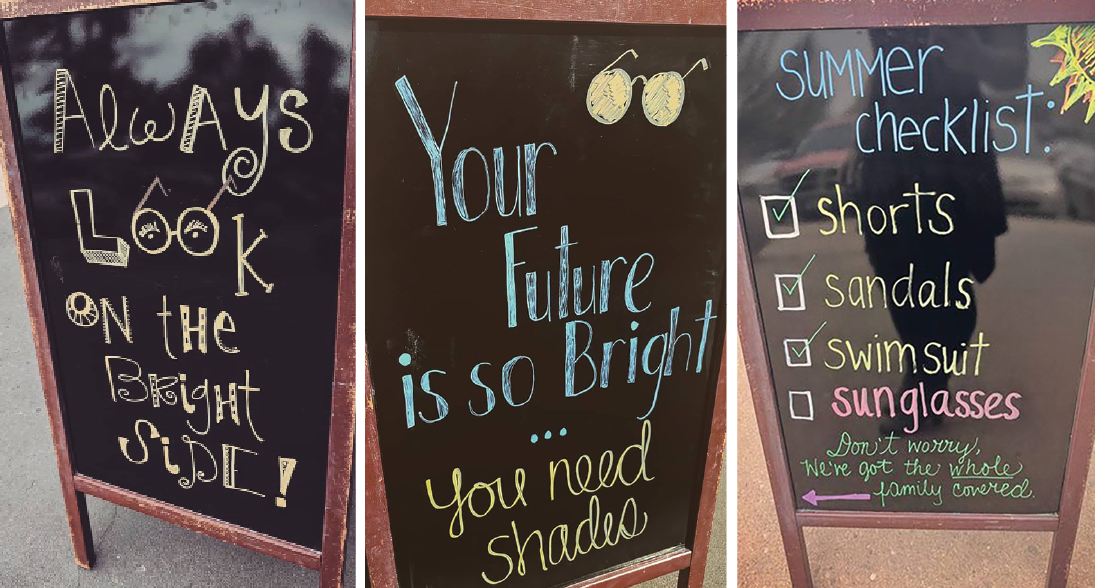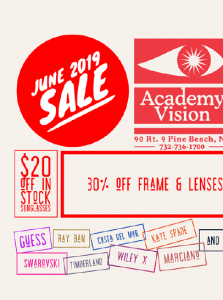We recently consulted members of the eyecare community and a handful of business experts, asking them to tell us about some aspect of the business they’ve got down really well, and to boil that activity or practice down to its key components. What started out as a list of standout skills soon blossomed into an ECP’s guide to … pretty much, everything! Well … to a whole lot of really cool stuff, anyway. We’re pretty confident that reading this you’ll learn a few new tricks, and see at least a few of your current methods in a new light. We challenge you to implement one or two of these 23 practices — at least in some form — before the year is out.
HOW TO ENGAGE AUTHENTICALLY WITH YOUR COMMUNITY
Julie Kubsch, Specs Around Town, Bloomington, IL
Julie Kubsch, owner of Specs Around Town in Bloomington, IL, believes that if you engage with as many people as possible you’ll find someone who needs or wants your services — or who will know someone that does. Among the groups and events she has found most rewarding are: Bloomington-Normal Sunrise Rotary (“‘Service above self’ is the motto of Rotary and if you live it, it’s amazing what you can accomplish,” she says.); McLean County Chamber of Commerce (networking events); local radio station WGLT/NPR (“a perfect avenue for reaching clients that are fun, unique and love supporting local businesses”); and the downtown Bloomington business owners group’s monthly happy hour, hosted by a different business each time (“Nice resource to discuss downtown concerns, learn of other businesses in our area and creates a sense of family in regard to small, independent businesses.”) While financial benefits are the ultimate goal, Kubsch says, “hearing a comment like ‘Every time I ask someone where they got their glasses they say Specs Around Town!’ is good for the heart and soul.”
HOW TO MAKE THE BEST SANDWICH BOARDS

Heather Harrington, Elevated Eyecare, Denver, CO
By her own estimation, Heather Harrington at Elevated Eyecare in Denver, CO, makes the best sandwich boards in the business. We took her at her word and asked her to break down her approach — and the feedback.
- INSPIRATION: Harrington gets hers from patients, the time of year, “and our office’s love for the overall health of the eye and clarity in vision.”
- KEEP IT FRESH: She changes hers up twice a month or so.
- MATERIALS: Harrington prefers chalk, with everything drawn in freehand.
- LOCATION: In addition to placing them outside the business, she always posts all boards to her socials. “Of course!” she says. “Lots of hard work and thought goes into the boards for the month.”
- RESPONSE: “Nothing but great things!”
HOW TO MAKE YOUR WEBSITE SERVE YOUR BRAND AND YOUR BOTTOM LINE
Selina McGee, OD, Precision Vision, Edmond, OK
Dr. Selina McGee at Precision Vision in Edmond, OK, has an eye for design but not the skills to translate that into a website. For that, she relied on marketing partner Gunnar Hood at WSI-Summit. (See what you think here www.pvedmond.com). She focuses her advice thus:
- Find a web designer who can translate your ideas into reality.
- Choose an appropriate platform: Precision Vision’s site is hosted on an SaaS platform called Duda, selected by Hood. “We like it because it is hassle free, supports SEO really well and accommodates all of our design needs.”
- Use web analytics tools. Google Analytics, Google Search Console, heat mapping and other tools help monitor site performance, search engine optimization and social media reach.
- Set goals. McGee’s were for the site to function as an extension of the office experience; to be phone-friendly; and to educate.
- Include educational content. This captures views from beyond your area. “An article about bumps on eyelids is ranking well nationally.”
- Don’t tinker constantly, McGee says, but consider a change if your site no longer reflects your brand and message, or isn’t meeting patients’ needs.

HOW TO KEEP YOUR WINDOW DISPLAYS FRESH
Jenni Leuzzi, Mill Creek Optical, Dansville, NY
At various times, the display windows at Mill Creek Optical in Dansville, NY have been graced by stuffed cows wearing shades; chickens eggs hatching kids’ glasses; a tipped-over picnic basket full of suns; and a vintage Fisher Price display. Here’s what owner Jenni Leuzzi focuses on:
- For inspiration, in addition to holidays and seasons, Dansville has a full calendar of festivals and events. Check your town for something similar. She combs magazines and Pinterest, while some occasions suggest themselves: On Harry Potter-related dates: round frames in the window.
- She stores a lot of props for re-use. Among these are old wooden boxes and crates, which can be draped in material. Items are found everywhere: “Garage sales, antique shops, Home Goods, Amazon, my basement…” Always be looking for something that can be used… or re-used.
- The goal is to draw attention to your shop; don’t let your display become part of the unchanging scenery of the street. Leuzzi redoes her windows every three or four weeks.
HOW TO DEMO PRODUCTS & SERVICES ON FACEBOOK LIVE
Nancy Rausman, managing editor at EyeCarePro (eyecarepro.net), a consultant for the optical industry, says Facebook live is a great way for practices to build relationships, share expertise and products, and show the personal side of their business.
DO:
- Provide value. Keep the focus on demonstrating services or displaying eyewear.
- Write a compelling description. Before your audience decides whether to join you, they will read this.
- Test lighting, sound and picture by selecting the privacy setting “only me” (in the “share with” section select “more” and scroll down).
- Interact with your audience. Tag friends and patients to let them know the talk is happening; respond to chat; welcome people by name.
DON’T:
- Forget to publicize your talk in advance.
- Be overly promotional. This isn’t a commercial. No one wants to listen to 10 minutes of self-praise.
HOW TO EFFECTIVELY COMMUNICATE CHANGES TO CUSTOMERS
Marc Ullman, OD, Academy Vision in Pine Beach, NJ
 During summer, Academy Vision in Pine Beach, NJ, takes off every other Friday. Here’s what Dr. Marc Ullman and the team do to keep people from driving all the way there only to find them closed.
During summer, Academy Vision in Pine Beach, NJ, takes off every other Friday. Here’s what Dr. Marc Ullman and the team do to keep people from driving all the way there only to find them closed.
- Two or three weeks in advance, a message is posted alerting customers on Facebook, Google, the front door and website, and the phone message is updated.
- The message itself is typically worded along the lines of: “Hello our amazing patients, the staff at Academy Vision will be taking time to enjoy our families this week.”
- Messages are pinned along with all events to the top of social pages.
- The door signage is professionally done. “It’s important to show we care about how you view our office, and the importance of spending time with family.”
- Ullman reminds ECPs that “not everyone is on social media” — be prepared to field a few complaints.

HOW TO HIRE RIGHT EVERY TIME
Diana Canto Sims, OD, Buena Vista Optical, Chicago, IL
“Bringing new staff on board is pricey and time consuming; we have found our system works wonders funneling in the best candidates,” says Diana Canto Sims, co-owner of Buena Vista Optical in Chicago, IL. Here’s her rundown of the process:
- A link is posted to an application with an invitation to schedule a phone interview at a day and time chosen by the candidate from a number of pre-determined slots. The slots are chosen ahead of time with a program called Acuity Scheduling. The application functions as the candidate’s resume.
- For those who pass the phone interview, a face-to-face interview with a tour of the facilities. When they are also given a “logic and reasoning written test.”
- Paid working interview. Conducted after they have passed the face-to-face. “We see their work ethic, reliability, team-playing ability and how they treat patients.”
- Lastly, a candidate is selected from those funneled to the top. Some final advice, allow for trial and error, says Canto Sims. “It took us 11 years to perfect.
HOW TO START AN ABO TRAINING PROGRAM IN YOUR AREA
James Armstrong, Alberta Eye Care, Portland, OR
“Since opening our optical almost seven years ago, the most obvious challenge has been finding and retaining staff, particularly qualified opticians, and our office was not alone,” explains James Armstrong of Alberta and Cathedral Eye Care in Portland, OR. The shortage in the labor market has led to higher turnover and overhead costs, so Armstrong reached out to Portland Community College, and pitched the formation of an ABO training program in their medical career training department. “The idea was met with enthusiasm, but obstacles also presented themselves.”
- Be able to demonstrate the demand in our local market.
- Find an instructor. “It took two years of networking and reaching out to industry partners before the connection was finally made that led to finding Andrew Bruce, a master optician with decades of optical management experience, as our instructor,” shares Armstrong.
- Know how to navigate the classic optometry vs. ophthalmology politics. “PCC has had an Ophthalmic Medical Technician program for years. I argued adding the ABO training program could only strengthen the college’s position in the eyecare field but those running the OMT program were concerned our program would potentially steer candidates away, or lower the future job prospects of the OMT graduates.” It took six months for Armstrong to convince everyone involved that opticians are not technicians and vice-versa. “What seemed like an obvious argument to myself and everyone else in our industry proved to be a very challenging hurdle for this program to overcome.”
- Be patient. “Three years after I approached PCC about this program, Optician ABO Prep is officially a go and accepting students for January 2020!”
HOW TO WORK FASTER
Caitlin Wicka, San Juan Eye Center, Montrose, CO
Caitlin Wicka of San Juan Eye Center in Montrose, CO, isn’t sure why her ability to work with multiple patients at one time is so rare. Here’s what she does know about squeezing the most out of a workday:
DO:
- Give trays to customers shopping for frames. “This allows them to look while you help change a nose pad or dispense.”
- Offer guidance on store layout before a customer begins browsing.
- Use the Ultrasonic cleaner as a way to make time to help someone else.
- Look up insurance and patients before you sit with them.
- Know your inventory and what you can order relative to the Rx you’re looking at.
- Slow down, if it means making fewer mistakes.
- Get your workspace set up with the tools that you most commonly use.
DON’T:
- Chat with patients. “Let them talk to you, don’t talk at them.”
- Deal with vendors/reps ahead of customers. “If a rep comes in, get them to help your patient look for glasses.”
HOW TO ANNOUNCE A FIRING TO THE REST OF YOUR STAFF
The basic rules of firing apply here. Firstly, do it quickly. Secondly, provide enough information to demonstrate the decision wasn’t arbitrary, but not so much detail that you look like you’re trying to embarrass someone. Be low-key, brief, stick to the facts and avoid emotion. Alison Green, author of the “Ask a Manager” blog, offers the following sample script for an email that she recommends be sent to the whole staff on the day of the firing.
”Unfortunately, Jane’s last day with us was today. We wish her the best of luck, and we’ll be moving quickly to hire a replacement. Until her replacement is hired, please see Fergus with questions about teapot research and Lucinda for any other questions.”
Green adds that “Your staff will generally understand that you’re not going to share every detail with them in cases like this,” while reminding managers that the key is to ensure that your staff understands how performance problems are handled.
HOW TO HANDLE AN EMPLOYEE WHO WON’T TAKE THE HINT
Back to “Ask a Manager” blogger Alison Green for this one: She advises that in fact it’s not your job to manage an employee’s reactions; if they don’t get it, it might be time to show them the door. “If an employee’s refusing to hear clear warnings, you don’t have to keep hammering the point home.” But before you pull the trigger, she does advise that you revisit the language you’ve been using with the employee. Have you been clear? “Sometimes managers think they have, but when we dig into exactly what they’ve said, it turns out that their wording has been mushier than they thought. In particular, managers are sometimes reluctant to say words like ‘If you don’t do XYZ, I will need to let you go.’” So, don’t be fuzzy. A manager/owner’s responsibility in this situation isn’t to keep issuing warnings — it’s to ensure that their warnings are clear. If not, Green says, “It’s time to move to a conclusion.”

HOW TO GET WHAT YOU WANT, AND NEED, FROM A SALES REP
Lorie McBroom, Bakersfield Eye Care, Bakersfield, CA
5 Bakersfield Eye Care in Bakersfield, CA, had tried several colorful frame collections that didn’t do well, so adding Etnia Barcelona felt like a bit of a gamble. Optical manager Lorie McBroom recalls telling the rep, “‘I love the brand, but it would be amazing if we could have 90 days to try it out to see how it would work. And the rep said, ‘Let’s make that happen.’” The line was a hit. “It’s worked out for us, as well as for our vendor, just to ask for the things that you want.” Something else McBroom has learned is that reps are a great resource for recommendations beyond their own brands. A good example of this is Matsuda, one of the first high-end lines they added. Its rep wasn’t familiar with Bakersfield, but another salesperson — who’d already brought Etnia Barcelona and Garrett Leight to the shop — vouched for what Bakersfield Eye Care was up to. By the time the Matsuda rep finally visited in person, “we had already sold through most of our Matsuda we bought at Expo, including a show-stopping frame that retailed for over $1,500,” says McBroom.
HOW TO SELL FROM THE CHAIR
Chris Lopez, OD, Roberts Eyecare Associates, Vestal, NY
To the eye docs reading this: We get it — you’re NOT salespeople. But there are ways to boost eyewear sales from the chair without feeling like you’re selling, and without dragging discussions of fees/costs into the exam room. Here are a few, provided by Dr. Chris Lopez of Roberts Eyecare Associates in Vestal, NY.
- A key point from a sales point of view comes after refraction. Says Dr. Lopez, “If there is a moderate-significant refractive change, I demonstrate the change for the patient using their current prescription and the new one with the phoroptor. That’s a main selling point.”
- Ask patients about their lifestyle. What recommendations present themselves? Says Lopez: “A prescription is what I deem necessary to provide the patient with the sharpest and most comfortable vision possible. A recommendation is what I think the patient could benefit from but which is not necessary.” ODs are within their rights to make both, he says. Discuss your recommendations as you walk patients to the handoff.
- Ask all presbyopic patients if they’ve heard about multifocal contact lenses, an option that can get them out of reading glasses or bifocals/PALs. Many Baby Boomers and younger presbyopes are very conscious about their appearance. Being able to solve their near vision problem and helping them look young will make you a hero.
- Raise the potential benefits of anti-fatigue lenses and daily disposables with appropriate patients during the exam. “With more and more patients reporting eye strain or tired eyes towards the end of the day, anti-fatigue lenses have earned a spot in my patient education armamentarium,” he says. “And I put any young patient (children and teenagers) into a daily disposable contact lens if it’s a new fit. It’s best to start healthy habits from the get go.”
- “Always. Always. Have I said ALWAYS yet? I always ask patients at the end of the exam if they have any questions for me, or if there is anything that I haven’t answered for them. It gives them an opportunity to express all of their concerns and it allows you to once again educate and solve problems.”
HOW TO OFFER FREEBIES THAT MAKE YOU MONEY
Nancy Revis, Uber Optics, Petaluma, CA
“We are known to have fun free stuff,” says Nancy Revis, owner of Uber Optics in Petaluma, CA. She studied graphic design and marketing, so fun giveaways come naturally. “I had matchboxes made with our logo. Nice pens with our logo. We had beer coozies made that say ‘For your beer goggles.’ We always have fresh red vines and have a kitchen-size fridge full of beer and sparkling water. We have mints and chocolate all over the shop … especially mints because we are all in each other’s faces, so that is important.” Revis isn’t above setting the occasional sugar trap, either: “Now the little kids remember that I have red vines on the coffee table so they drag their parents in when they are walking by. I have totally sold sunglasses from them being dragged through the store for candy.” Selling suns doesn’t get any sweeter.
HOW TO BOOST WORD OF MOUTH BY DELIVERING A ‘WOW’ EYE EXAM
Robert M Easton, Jr, OD, Oakland Park, FL
Dr. Robert Easton in Oakland Park, FL, offers comprehensive eyecare and, when indicated, topography and a wellness OCT at no extra charge. Patients are shown the results in the exam room on flat screen HDTVs. He points out that topography is an excellent way to pick up a range of disorders. And “if a patient has a family history of glaucoma and/or deep cups, and/or high normal eye pressures, I want to be sure their Ganglion Cell Thickness is normal and I’ll run an Optovue Wellness exam. Furthermore, before I refer a patient for cataract surgery or Lasik I run an Optovue Wellness exam to rule out any retinal issues prior to surgery.” He adds that patients are more likely to accept treatment recommendations when he blows up their tests on a flat screen TV. “Because I do this as part of the comprehensive eye exam, I do not charge the patient. Many patients have referred their family members because of our thoroughness.” Business is so good, in fact, Easton doesn’t advertise.
HOW TO MANAGE FIRST TIME PRESBYOPES/PROGRESSIVE WEARERS
Kim Hilgers, Monson Eyecare Center, Owatonna, MN
A “no surprises” approach for first time progressive wearers is advocated by Kim Hilgers at Monson Eyecare Center in Owatonna, MN. Here’s her advice:
- “I start by explaining that the ground won’t be clear when they look down because the viewing area is only 14-18 inches in the distance. I talk about steps and curbs (and vacuuming) being a challenge. I like to make a drawing to show them the reading area isn’t all the way across the lens.”
- “The OptiKam has an amazing virtual lens demonstrator that the patient can hold and see more realistically what to expect.”
- “Varilux Physio and Physio Drx are my go-tos. I’m kind of obsessing about Varilux X series right now for higher presbyopes.”
- “I would say 95 percent of first-time progressive wearers are first-time presbyopes. I implore my doctors to speak to them about this as early as possible in their journey of presbyopia, to make MY job easier.”
HOW TO FIND/MAKE THE BEST USE OF AN OPTOMETRIC EXTERN
Mark Perry, OD, Vision Health Institute, Orlando, FL
Whereas internships are usually narrowly focused, months-long paid arrangements involving an employment agreement, and specific duties, externships (the word combines “experience” and “internship”) last a day to a few weeks, are unpaid, informal, have no major deliverables and often involve a student shadowing a doctor or simply observing what goes on. Dr. Mark Perry at Vision Health Institute in Orlando, FL offers the following advice to those thinking of bringing one (or more) on board:
- Be dedicated to the profession, willing to instruct and help them adapt to patient encounters — lead by example!
- Make sure your office is accommodating (and busy enough) to the optometry school, as well as the student (medical model of practice, latest equipment, etc.).
- Start with your alma mater — contact the director or manager of the externship programs.
- Be prepared to spend time with them.
- Get staff to embrace and engage with the students.
- Be prepared to learn from them!
HOW TO HANDLE VERY YOUNG CHILDREN
Nikki Griffin and Sara Mabie, OD, EyeStyles Optical and Boutique, Oakdale, MN
Nikki Griffin, owner/optician at EyeStyles Optical and Boutique in Oakdale, MN, fits babies as young as three months, so she knows a thing or two about doing it well. Her advice for opticians:
- Fit them for now. Not yesterday, not a month from now.
- If you don’t have the right size, admit it and refer to someone who does. Otherwise you’ll drive those people online.
- Watch for endpieces that stick out too far.
- Fit a frame to sit high.
- Toddler tip: Use two penlights to get a PD. One to shine on their eye and another for them to shine at you.
Lastly, for optometrists looking to work with more kids: “Think like a kid,” advises EyeStyles’ OD, Dr. Sara Mabie. “A toddler might see a symbol of a rotary phone in a turtle. Be flexible — sometimes even getting on the floor for the wiggle worms. Have a variety of bright flashing toys to pull out, not a creepy puppet. Their attention span is short so change objects often. Oh, and keep moving!”
HOW TO GIVE AN EDUCATIONAL TALK
Taylor Little, OD, Eye Care Center of Colorado Springs, CO
According to Bob Levoy, author of 201 Secrets of a High Performance Optometric Practice, “the average optometrist has all the qualifications needed to become an effective public speaker. It’s really just an extension of in-office patient education.” By getting on the speaking circuit, you’ll be harnessing the power of your knowledge to bring in new patients. One doctor who’s already using this approach is Dr. Taylor Little at Eye Care Center of Colorado Springs, CO. Dr. Little urges other ODs to:
- Decide on your expertise and have a direction before you start organizing your lecture.
- Look for smaller events that need volunteers first.
- Practice aloud beforehand.
- Utilize pauses.
- Choose a way to increase engagement with questions or surveys.
Levoy reminds ECPs not to turn the event into an advertisement. “The optometrist whose only motivation for public speaking is to obtain new patients will come across as self-serving … Establish yourself as an ‘authority,’ not as someone who is ‘looking for business.’”
HOW TO TELL A JOKE
Sometimes the route to “Yes” is through a customer’s funnybone. But before you clear your throat and dust off your knock-knock jokes, here are some thoughts from the guys in white jackets who know how to be funny:
- Be self-deprecating, but don’t overdo it. In his sales blog at yesware.com, a sales productivity platform, Lou Carlozo counsels that sales humor at your own expense is safe, but don’t make yourself appear incompetent. You can joke about your hairline but don’t undermine your product line. He adds that self-effacing humor builds trust to show the real human being behind the salesperson; it creates a sense of authenticity.
- Queens, NY-based standup comic Hari Kondabolu had this to say to The New York Times’ tip columnist Malia Wollan on the topic of joke-telling: “People should not be able to telegraph where a joke’s going.’’ Kondabolu says stock or street jokes — the kind you read in a joke compendium — are almost never funny. So, work on your ability to slip jokes naturally into conversation (i.e., don’t start with “Want to hear a joke?”).
- If you must tell a joke involving an animal, ducks make for the funniest quips, according to a global survey done by scientists at the University of Hertfordshire, Wollan reports.

HOW TO BANISH BAD VIBES
Morgan Bartel, Collins Diamonds, Liberal, KS
Morgan Bartel, the owner of Collins Diamonds in Liberal, KS, told our sister publication INSTORE that “It’s store policy that we have no bad attitudes, conversations regarding politics, religion or anything that could cause any negative vibes. We believe in the law of attraction, which means that whatever thoughts/words we put out there or allow to be said within our store bring about either good or bad feelings. We have given numerous customers the opportunity to step outside and rethink their attitude. Some have immediately changed their tone, while others took their given opportunity, started looking at the bright side and then re-entered our store with a much more positive spirit!”
HOW TO FIRE A CLIENT
Tania Sotelo, Balfour Vision Optix, Brentwood, CA
 It’s smart to set and maintain a chain of command and have a policy on what to do with people who disrupt your business. Staff tasked with carrying out the order should make it clear to the patient that it’s the doc’s call, and invoke their name, ideally in a brief conversation or call, but it can be done in an email. “Dr. Smith feels it’s time for you to find a new doctor, as we don’t seem able to meet your needs in our office,” Tania Sotelo of Balfour Vision Optix in Brentwood, CA, says. “We have a letter we mail to them stating we unfortunately have not been able to meet their needs and feel it’s best for us to terminate the business relationship,” she says. “We give them a 30-day notice for emergency services only and offer help finding another doctor if needed.”
It’s smart to set and maintain a chain of command and have a policy on what to do with people who disrupt your business. Staff tasked with carrying out the order should make it clear to the patient that it’s the doc’s call, and invoke their name, ideally in a brief conversation or call, but it can be done in an email. “Dr. Smith feels it’s time for you to find a new doctor, as we don’t seem able to meet your needs in our office,” Tania Sotelo of Balfour Vision Optix in Brentwood, CA, says. “We have a letter we mail to them stating we unfortunately have not been able to meet their needs and feel it’s best for us to terminate the business relationship,” she says. “We give them a 30-day notice for emergency services only and offer help finding another doctor if needed.”
HOW TO DEAL WITH A NATURAL DISASTER WITH HEART
Texas Smith, OD, Dr. Texas L. Smith & Associates, Citrus Heights, CA
Northern California’s Camp Fire killed 85 people and destroyed nearly 19,000 homes last year. Survivors who made their way to Dr. Texas L. Smith & Associates in Citrus Heights, CA, were seen and given Rxs for free. The idea began when VSP started providing vouchers for eye exams and glasses after the fire. “Several patients came in with the vouchers and I would ask them if anyone in their family needed eyecare,” explained Smith, who later reached out to VSP for more vouchers, and eventually just began providing survivors with needed care and Rxs at no charge. Smith has a history of quietly giving back. He has volunteered eyecare for homeless veterans, which, as a Vietnam vet himself, he says is “a no brainer.” He also volunteers with the VSP Mobile Clinic at Loaves and Fishes in Sacramento. “Optometry has been very good to my family so I need to pay it forward. Just doing my best to make a positive difference,” he says. Fires, hurricanes, floods, earthquakes, it seems Mother Nature has no shortage of disasters. Are you doing your part?